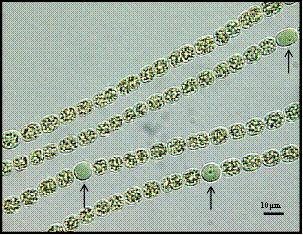Hydrogen production from photosynthetic cyanobacteria:
Quantitative modeling of culture profiles
Cyanobacteria are among the most important and fascinating candidates for photobiological hydrogen production. Using sunlight as the source of energy and air as the source of carbon dioxide (CO2) and nitrogen (N2), they are capable of performing photosynthesis, splitting water into H2 and oxygen (O2).
In N2-fixing cyanobacteria, H2 is mainly produced as an obligatory byproduct of nitrogen fixation. Nitrogenase is the enzyme complex that catalyzes this reaction. However, it is sensitive to oxygen. To overcome this obstacle, some filamentous cyanobacteria have evolved to differentiate specialized cells called heterocysts, which possess a protecting cell envelope to limit O2 penetration and an inactive photosystem II to prevent O2 evolution. Heterocysts rely on the surrounding vegetative (photosynthetic) cells for the import of carbohydrates as the energy source. In return, they export the fixed nitrogen to vegetative cells for growth. Quantitative description of the ratio between heterocysts and vegetative cells as well as their symbiotic interaction is of critical importance to the development of H2 production processes using the heterocystous cyanobacteria.

Interchange of carbohydrates and nitrogen in filamentous cyanobacteria
Heterocyst differentiation is regulated by the N-source condition of the filament. When no external N-source is available, some vegetative cells will start developing into new heterocysts and, when mature heterocysts are formed, the expression of the corresponding nitrogenase will initiate to support the fixed nitrogen needs of the filament. Within a filament, the heterocysts are typically differentiated in positions where they can attain the most efficient production and distribution of fixed nitrogen to the vegetative cells. Despite the significant advances in genetic investigation on heterocyst differentiation, there is no quantitative modeling at the system or process level that describes the effects of cellular activities and cultivation conditions on the heterocyst differentiation, and vice versa. Such a model has been developed in this laboratory, incorporating photosynthetic growth of vegetative cells, heterocyst differentiation, self-shading effect on light penetration, and nitrogen fixation. The heterocystous cyanobacterium Anabaena flos-aquae CCAP 1403/13f was used in this study.
 |
| Vegetative (photosynthetic cells) and heterocysts cells of Anabaena flos-aquae. Arrows point to heterocysts |
Another crucial factor not only for H2 production but in all photobiological processes is the light distribution. The productivity and economics of these processes are usually limited by low light utilization efficiency. This phenomenon is associated with different factors, such as the light saturation effect, the light at wavelengths less effective for photosynthesis, and the culture’s self-shading effect. To efficiently take advantage of the potential of cyanobacteria, a highly efficient light source is desired for growth studies and cultivation. Other key issues, such as light delivery and its distribution inside the photobioreactor are also of great importance in the successful implementation of the photosynthetic process. Studies on the effect of light intensity and wavelength on growth, as well as on the heterocyst differentiation process and nitrogen fixation kinetics are being conducted in this laboratory.
>Click Here to Learn More About Cyanobacteria’s Gas Vesicles<
Publications:
Modeling culture profiles of heterocystous N2-fixing cyanobacterium Anabaena flos-aquae. (N. M. Pinzon and L.-K. Ju) Biotechnology Progress 22(6), 1532-1540 (2006). DOI Link
Effects of polyethyleneimine on cyanobacterium Anabaena flos-aquae during cell flocculation and flotation. (S. A. Arrington, M. J. Zeleznik, D. W. Ott and L.-K. Ju) Enzyme and Microbial Technology 32 (2), 290-293 (2003).